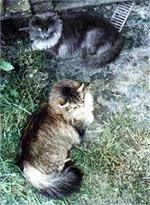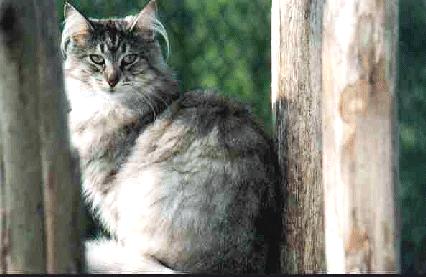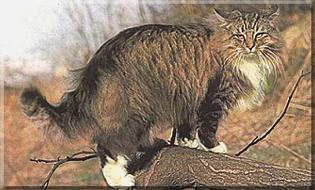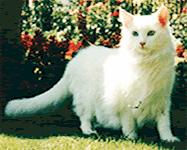The Norwegian Forest Cat
 When Mother Nature recreates herself she does it in a majestic way. The harmony, elegance and intelligence are her fundamental weapons. The results are wonderful.
When Mother Nature recreates herself she does it in a majestic way. The harmony, elegance and intelligence are her fundamental weapons. The results are wonderful.
When we observe her creations, enjoying the view of a landscape or watching at dusk the death of the waves reaching the sea beaches, we get in touch with Her, and we are touched by an unique and particular sensation when we realize that everyone of us is part of Her.
The Norwegian Forest Cat is a clear evidence of how much the natural conditions obtain from their characteristic patience. This fragment of forest, this sparkle of aurora borealis is like having a piece of nature in our house.
History
Long time ago, maybe during the prehistory, cats of short hair emigrated towards the north; once arrived they adapted to the new environment and survived developing special racial characteristics that allowed them to live in the hardest climate. The history of these cats is full of legend and places them near the Gods and next to the fairies. It's well known that two white cats were used to pull Freya goddess's cart and that the powerful Thor could not raise them with its hands.
Far from legends, the first real references go back to 1550 and come from a Danish naturalistic priest who lived in Norway and worked classifying the flora and fauna of Scandinavia; Peter Clussoan Früs in his works makes a division between the lynxes: the lynx-wolf, the lynx-fox and the lynx-cat. Surely it was only the Skogkatt; its reseemblence with the lynx was evident: necklace, plumetis in the ears and the tone of the coat, and not only aesthetically they looked alike: their ability to fish in the lakes, the skill at the time of hunting birds and their skill climbing up and down of rocks and trees caused the confusion. But then in 1912, a Norwegian author, Gabriel Scott, wrote a book for children in which the main character was a cat of the Forests named "Solvfaks".
Whith the beginning of nothern europe's development, settlers took on their way to their farms shorthaired cats with them, these began to mate with cats of the Forests that until that moment had stayed far from the man, this put the species in jeopardy, therefore during the Thirties the Norwegians began to worry about their native cat's preservation.
The walking begins. In order to be consider a cat as authentic of the breed, breeders had to submitt their cats and its litters to a commission that considered if they were suitables and if they fulfilled all the requirements that by those days were considered a must to raise only authentic cats of the Forests; they ought to have all the attributes and characteristics that distinguished this specific cat from any other: hair, size, morphology, character, etc.
These pioneers worked slowly and rigorously until processing a standard and thus put into words and scores those qualities that Nature had determined time ago with cold weather and extreme survival conditions. It was necessary in order to protect the breed. To avoid crossings with any other cat. That's why the Norwegian Forest Cat is unique, special, but mainly "natural", because the hand of the man took part intervention was only to safeguard its purity and to conserve its primitive characteristics, fighting against fashions or whims. It is easy to understand that the Scandinavians wanted to protect an animal that reunites in itself something so difficult to find: the sweetest character, a surprising skill and a fantastic beauty that put this cat in a scope that goes from the absolute admiration to the constant surprise.

Let us follow with its history. In 1969 thirteen Norwegians participated in exhibitions and three years later the breed was recognized by the norwegian feline associations then started the process to come up with the first standard. Two years later the crossing of "Pippa" with "Truls" gave the first Norwegians recognized as a breed. They were "Pjewiks Truls" and "Pjewiks Nisse". On 1975, Kari Eggun together with Liven Loose and Egil Nylund founded the Norsk Skogkattring that gave impulse and strength to the development of the breed. In 1976 it is recognized by the FIFé.

PR. N* Truls (Pan's) -NFO n 09 23 (Male)
A delegation composed by Carl-Frederik, Elen Nordane and Arvid Engh travelled to Paris, nevertheless the star of the moment, "Pan's Truls", the cat that had served as model in the creation of the standard, could not travel with them. The border laws of Norway would prevent that the cat returned without undergoing a quarantine. When the norwegian delegation returned Truls went to the airport to greet them. He was already very well known because of his appearances in the television as well as the declaration of king Olaf to grant to the "Norsk Skogkatt" the category of national mascot that had given so much popularity him, and thus this vikingo that traveled underdeck in the holds of the old "drakkars" began a new period conquering us by his beauty and intelligence.
The first American feline organization who recognized the breed was TICA, that elaborated their first breed standard between 1984 - 1985; the first Norwegians registered in CFA go back to 1987 and began to compete in 1993. Just when celebrating the twentieth anniversary of the reconognizing of the breed by FIFé, the CFA published a special review of the Norwegian Forests in her 1996 Yearbook.
The export was very difficult and restricted in the beginning: a cat could not leave Norway without an agreement of the raising commission of the Norwqy Feline Federation. But Europe had already fallen in love with the charms of this breed and many of the current breeders embarked, despite all the difficulties in the comforting task of raising these cats. First European Champion beyond the Scandinavian borders was "Jakobellas Max", a black and white male tabby tiger owned by Margaret Leleither, who the same year founded the Club of Norwegian Forest Cat in Germany.
Until 1990 wild cats were allowed and sometimes we found them in our pedigrees. At the present time there is much controversy among the breeders regards the possibility to go back and work with wild cats taken from the natural environment. Many breeders state that there are sufficient genetic lines to work with without consanguinity; however others think that some of the characteristics of the breed are being lost and that they may be recovered with the arrival of new blood. At the moment it is very difficult that the category of beginners becomes open again, maybe one of the reasons for the refusal is that they would have to exist very strict commissions at the time of admitting a cat from the nature (wild cat), and of course only from Norway, its country of origin (although is known that the Forest has also been developed in Sweden and Finland).
But it is necessary to understand that a special reason influences also that decision making, specially between the Norwegian breeders, and it is not other than the sentimental one. Almost all breeders would like to own a cat directly taken from the forests. Just imagine the Norwegians looking at gorgeus animals jumping or climbing up the trees having no chance of accessing to their genetic lines. Perhaps in the future all breeders agree and make the decision that is best for our cats, that is what it's really matters.
All the colors in their natural habitat would correspond with certain places of Norway, each color adapts to the cat and acquires the necessary camouflage, because of this, it is said that the tabbies would live in the forests, the whites more to the north and the reds and the turtles towards the coasts, but whatever should be the color of his coat or the different drawings that embellish them, they are all spectacular. The quality of the coat of the agoutis compared to the non-agoutis advised to cross them because it seems that the agoutis cats do not have the slightly smoother hair that the non-agoutis have.
What does distinguishes the Norwegian Forest Cat of another type of cats?
Many and diverse facets, but there is something particular that makes him different and it is not other thing that not to have been ever crossed to other races.
Sometimes we hear that such breed has been crossed to another one to improve some characteristics; in this case it is not necessary, because their qualities are unique, and with this type of crossings only damage would be one to its uniqueness.
From an aesthetic point of view, its innate elegance, the distribution and the type of hair, exclusive of this cat; its wild aspect, but serene, its agility and its security, the dominion of its territory, etc. In the psychic aspects, its intelligence, the incredible capacity of communication with its familiar members: people, other cats, dogs, children, etc; the rapidity in learning when kittens, the infinite patience of the mother with her litter, to which they give to suckle over and over again, whenever their children, own or adoptive, demand it.
We spoke of a cat-cat. Just like this, imposing presence, simple in its behavior, near and affectionate, that obtains in a record time its place as a family member, and I can tell you that it is very important.
 When a Norwegian Forest Cat enters a family the house is covered by a particular charm: all dispute his affection, and it is funny to see that as time goes by the initial owner needs to reafirm more and more often that the cat is his, trying to settle down special bonds with his cat to distinguish himself in a special way from the lucky mortals who live with him. This, very wise cat, will give to each person its love, reserving his favorite companion certain behaviors that will only be shared in the absolute privacy.
When a Norwegian Forest Cat enters a family the house is covered by a particular charm: all dispute his affection, and it is funny to see that as time goes by the initial owner needs to reafirm more and more often that the cat is his, trying to settle down special bonds with his cat to distinguish himself in a special way from the lucky mortals who live with him. This, very wise cat, will give to each person its love, reserving his favorite companion certain behaviors that will only be shared in the absolute privacy.
Reproduced with the permission of:
La Zarina Cattery - Carmen Hierro & Maribel Lerones
